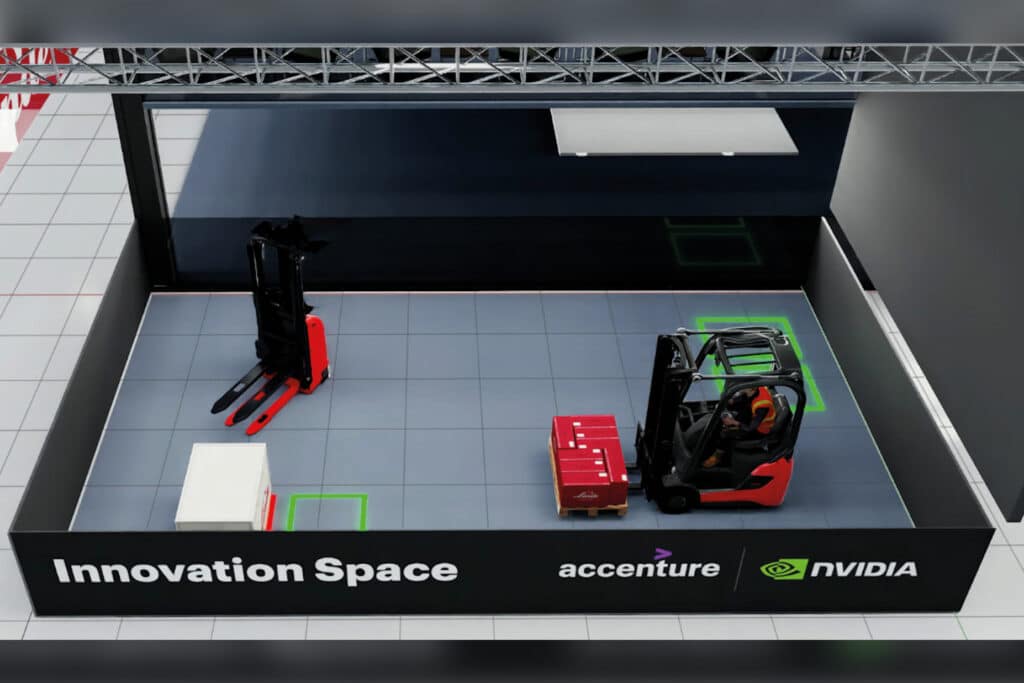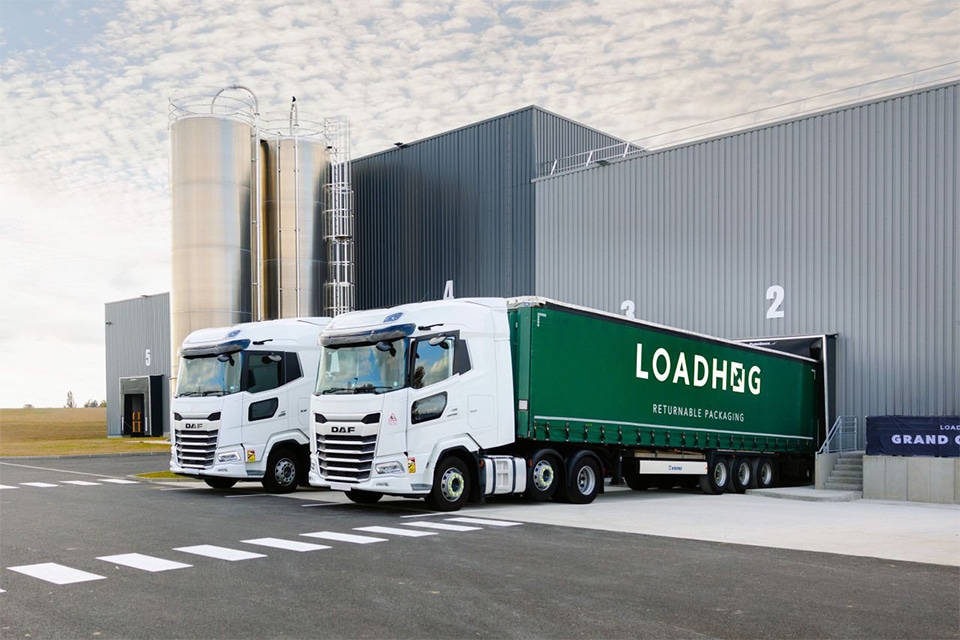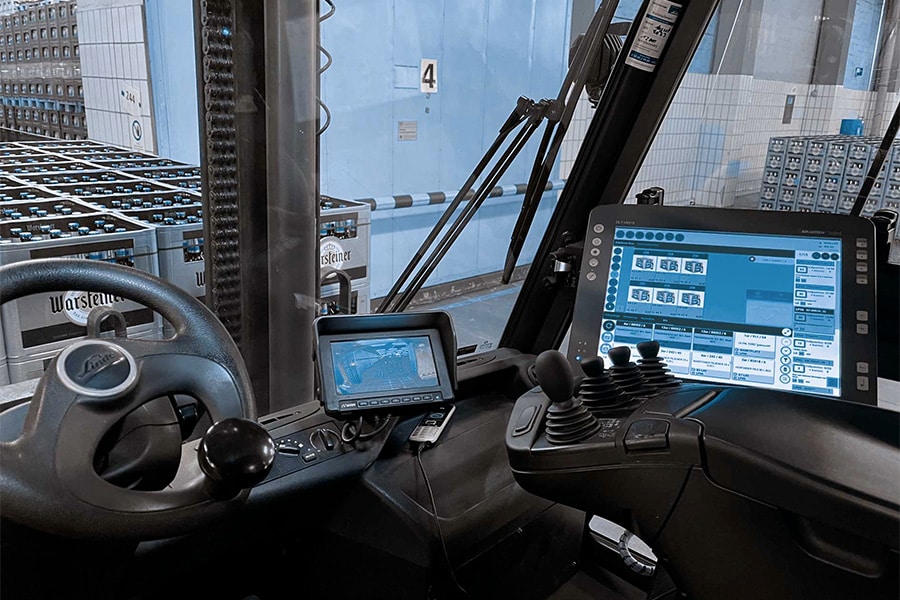
AI for real-time control of material handling
In the future, warehouse managers will increasingly be able to rely on artificial intelligence (AI) when it comes to optimizing material flow processes. During the technical showcase at the LogiMAT trade fair in Stuttgart recently, Linde Material Handling (MH) showed how this product vision works and is gradually becoming a reality. The solution is based on NVIDIA's powerful Omniverse AI platform, which uses a "digital twin" to collect, process and analyze massive amounts of data from warehouse operations in real time. This initiative joins Linde MH's parent company, the KION Group, which recently announced a large-scale collaboration with NVIDIA, a leader in AI, and Accenture, an expert in digitalization, to take industrial automation to a new level.
At LogiMAT, Linde showed a scenario that could be typical of the warehouse of the future - manual and automated trucks working in perfect harmony side by side using innovative AI technology. This development will be especially beneficial in large truck fleets. The integration of intelligent hardware and software, combined with computing power, ensures transparency of every process within the warehouse and allows for more efficient, reliable and flexible order processing through continuous simulation. "Artificial intelligence and neural networks will improve warehouse efficiency. Throughput will increase, both truck fleets with manual trucks and agv's can be optimized, and personnel can be used more efficiently. This will lead to significant cost savings for companies," said Ulrike Just, member of the Executive Board and responsible for Linde MH Sales & Service EMEA. "As a leader in technology and innovation in our industry, we are at the forefront of the development of AI-based solutions. These solutions represent a major breakthrough and are aimed at improving our customers' competitiveness and ensuring the long-term efficiency of their material flows. We are planning the first pilot projects with large customers, for whom the return on the investments involved will be particularly high."
Real-time localization creates transparency
The first step in Linde MH's strategy is to make manual material handling smarter by making it part of a network. Therefore, they are working on a new tracking system that shows exactly where each truck is - both inside and outside the warehouse. This system uses modern technology that requires little additional equipment. Drivers are shown route directions and new orders via a smart screen. The system takes into account the location of the truck as well as, for example, the position of the steering wheel. As a result, the route can be adjusted immediately, for example if it is busy somewhere, to avoid delays.
At some point, AI becomes indispensable
As warehouses become more complex, the optimization of routes and coordination of manual and automated material handling places much greater demands on capacity. "When there are 100 or more trucks to coordinate, it is essential to leverage higher-level intelligence and hardware capable of handling such large amounts of data," explains Ron Winkler, Managing Director of the Digital Business Unit at Linde MH. "This is where AI from the NVIDIA Omniverse platform comes around the corner. It creates a digital twin of the warehouse, a virtual 1:1 replica of the physical environment." In this digital twin, simulations can be run in fractions of a second - either to optimize routes and optimally coordinate AGVs and manual trucks, or to make optimizations in existing warehouse setups.
The main advantage is that solutions to changing warehouse conditions, such as new orders or inventory fluctuations, traffic congestion in certain warehouse areas, obstacles or overhanging loads, can be identified in real time, simulated in the digital twin and fed back to the truck control system. For example, if a truck arrives late, the system can automatically assign the nearest forklift to unload. To accomplish this, the NVIDIA Omniverse platform digitally stores all physical data of the material handling (e.g., payload, steering angle) and infrastructure (e.g., rack locations, routes, working hours). This virtual space then processes the constant stream of information coming from sensors, intelligent truck and infrastructure cameras, warehouse management software and truck control systems.
Simulation is the key
Intelligent camera systems, strategically installed throughout the warehouse infrastructure and on both manual and automated trucks, are used to track load carriers, AMRs and manual trucks. They also provide real-time monitoring of loading and storage areas. The images captured by these systems are then interpreted and processed directly by AI.
The showcase at Linde's booth demonstrated this in practice: A forklift driver transports goods to the receiving area with an electric Linde forklift. In the designated transfer area, a fully automated Linde stacker then picks up the pallet for further transport to the warehouse. To seamlessly document and track materials and goods on the Omniverse platform, the manual truck's mobile, intelligent camera automatically takes a picture of the load when the pallet is picked up and stores it in the system. At the same time, the camera records the entire environment, identifies people and obstacles, and immediately adjusts the truck's behavior to the situation. The cameras in the warehouse give the system information about the occupancy of the storage locations and also detect possible collisions with people, which should cause the trucks to reduce speed.
But what if the forklift driver does not place the pallet exactly on the specified plane, as an AGV usually requires? Through its cameras, the digital twin recognizes the pallet's placement and sends the order to the Linde L-MATIC core. Thanks to the intelligent camera on the fully automatic AGV, AI detects the skewed pallet and determines a solution - in this case, the best way to pick up the load. The cameras also detect problems such as boxes slipping or part of the load overhanging. In such cases, AI concludes that the AGV should not pick up the load. The Linde L-MATIC core then stops and is assigned to another transport job. Meanwhile, AI calculates which manual truck is nearby to take over the transport task.
"By configuring a digital twin of the warehouse, every conceivable infrastructure and fleet configuration can be simulated in 3D and tested for efficiency," explains Ron Winkler. "AI can be continuously trained and refined. This forms the basis for a warehouse system that proactively solves challenges and keeps getting better."
Heeft u vragen over dit artikel, project of product?
Neem dan rechtstreeks contact op met Motrac Internal Transport.
 Contact opnemen
Contact opnemen



